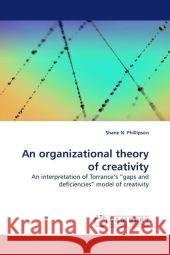An organizational theory of creativity » książka
An organizational theory of creativity
ISBN-13: 9783838303987 / Angielski / Miękka / 2010 / 300 str.
Mednick's Remote Associates Test for assessing creativity and Torrance's "gaps and deficiencies" model of creativity are based on the idea that creativity involves a comparison of the attributes of information. The research in this book tests this idea through the use of three sets of highly-analyzable stimuli, the data-analytic techniques of multidimensional scaling to visualize the organization of information and the fuzzy logical model of perception to model the responses to dissimilarity tasks. Using two groups of secondary school students that are distinguished on the basis of IQ scores, the results from this research show that there are individual differences in the organization of information and in the responses to the dissimilarity tasks, and that these differences are related to intelligence. This book will be of interest to researchers working in the area of intelligence and creativity.
Mednicks Remote Associates Test for assessing creativity and Torrances "gaps and deficiencies" model of creativity are based on the idea that creativity involves a comparison of the attributes of information. The research in this book tests this idea through the use of three sets of highly-analyzable stimuli, the data-analytic techniques of multidimensional scaling to visualize the organization of information and the fuzzy logical model of perception to model the responses to dissimilarity tasks. Using two groups of secondary school students that are distinguished on the basis of IQ scores, the results from this research show that there are individual differences in the organization of information and in the responses to the dissimilarity tasks, and that these differences are related to intelligence. This book will be of interest to researchers working in the area of intelligence and creativity.











